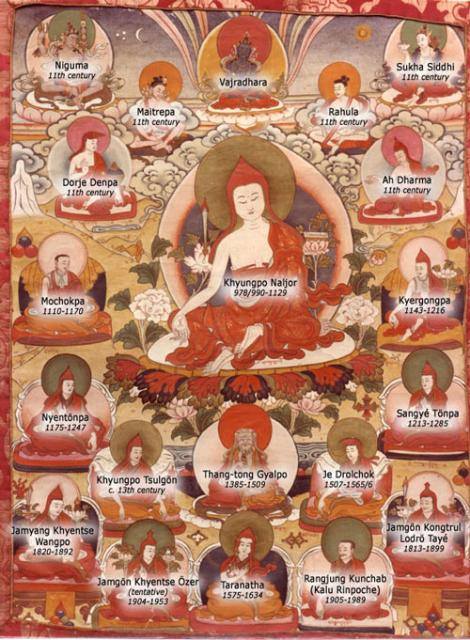Host: So one last question Rinpoche, often these teachings are considered very secret, so I was wondering how you think about secrecy. What is the role of secrecy? Vajrayana is often associated with, you know, “the secret teachings”. So what does secrecy mean in terms of Vajrayana in this context?
Kalu Rinpoche: You can search on the internet, there’s nothing much secret left.
You can say “I’m going to keep a secret” but there’s nothing much left. And Niguma herself, she mentioned, she said “my lineage, my Five Jewels of Niguma’s teachings and the Six Yogas of Niguma should kept secret until the seventh generation” that includes her. She said “have to keep this secret until the seventh generation. After the seventh generation, then the seventh lineage holder is permitted to give to the public”. You know, whether it’s a Five Jewels of Niguma, whether it’s all the teachings.
So that’s, that is the historical origin. Due to that, like an example, the Second Dalaï Lama, His Holiness Dalaï Lama was born in a Shangpa Kagyu family and his father was a retreat master overseeing the small temples in the retreat, centres and so on. As he reached the teenager age, he was already influenced by his father, and then he was recognised as a reincarnation of Dalaï Lama. So that has an influence on the Gelugpa lineage as well.
And then also during the seventh, after the seventh lineage holder, there was also a time where, how do you call it, Jonang lineage, like an example Taranatha revived many many teachings because many teachings are based on the, how do you call it, memorising, we call it སྙན་བརྒྱུད་ “nyen gyü” [oral transmission], “nyen gyü” means “I memorise everything, and then I say it to your ears, I don’t say it to anybody, you memorise everything, and then, and then I pass it to the next one”, so it’s called སྙན་བརྒྱུད་ “nyen gyü”.
So it was not just a singular lineage that was not allowed to make it public, but it was also “ear to ear” lineage and then, by the time of Taranatha and due to the size of the Tibet geography, you know, many teachings who are about to go extinct because people don’t have a social media platform, right? So you have to be little bit wealthy to receive Dharma, you can’t say that “I have a pure heart”, you know? You have to look after your own survival and you need to go for a very hard journey, you can’t take a sky train, there’s no metro. So you need to have that, all that possibility. And then on the top of that, the lineage to maintain. It’s almost like two impossible task combining together.
One is people coming together, is already challenging, and when the teaching is like “ear to ear” lineage, སྙན་བརྒྱུད་ “nyen gyü” and then that is the perfect scenario for lineage to disappear.
And then, so what Taranatha did, was that he revived many teachings, many practice, so due to him. Yes he wrote it down.

And then also, like an example, the concept of the Three Years Retreat, nowadays we know it, it’s relatively new. It’s not ancient as we think. And the concept of Three Years Retreat, one monastery start to do it, the other monastery copy it. Like an example you see the one rooftop looks similar, looks nice? Okay then next one does similar to that. And then, so therefore that became a trend, and that concept of Three Years Retreat, “okay this lineage is doing like that, that lineage is doing like this”, because if you look back, in, in a biography of Milarepa, there is no mention of so-called “Three Years Retreat”, there’s a lifetime retreat, which is far more than a retreat.
So we have to understand that “Oh, some practices are only allowed in the retreat”, yes, that is made up in a recent generation, but prior to that, before that, there’s a many, because otherwise all the teaching wouldn’t spread, you know? Because it wouldn’t spread to Gelugpa school, it wouldn’t spread to the Kagyupa school, it wouldn’t spread to the Jonang school, it wouldn’t spread anywhere, you know? So, so that’s that.
And my main purpose is to bring people to Dharma for physical and mental wellbeing. Not just giving an impression of “Oh, this is a Rinpoche, sitting on a high throne, he has an object in his hand, get a blessing, go back to your home”, you know? That impression is good, you know, if we have a culture mentality. But many people who are engaged in Buddhism, we, they don’t have a culture background. So what they need, is they need to have this, some form of a, they need to taste the flavour of “what is meaning of being a Buddhist and the Dharma practitioner?”, “what can you feel within your body and mind?”, “what is the difference before and after?”, you know?
So if they can feel that, do that, right? And then there’s no doubt they will learn further Buddha’s teaching. Whether, whichever the tradition may be, you know? It doesn’t mean that they have to stick with me and me only, you know? So, so that’s that.
Live with Kyabje Kalu Rinpoche on Wisdom Dharma Chats (38′ 28”)
Perspective on dharma in the modern world – 4th May 2023
To be continued …
Comments are closed.